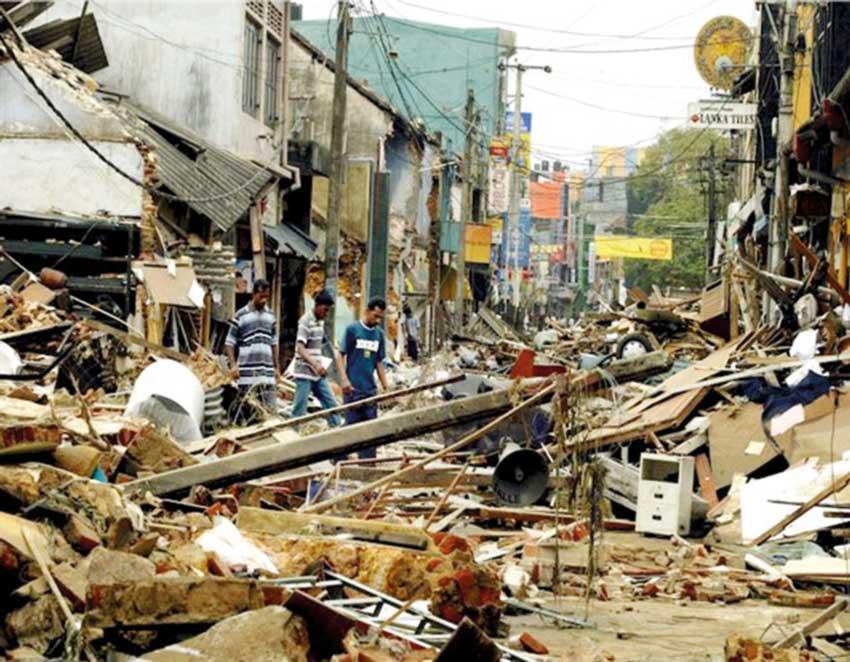Reply To:
Name - Reply Comment

The deadly devastation of the 2004 Boxing Day tsunami is remembered on December 4 every year
 It was a quiet morning. The main road was eerily silent. Then the phone rang like a thunderclap and life changed irrevocably.
It was a quiet morning. The main road was eerily silent. Then the phone rang like a thunderclap and life changed irrevocably.
No, it is not hyperbole, this is how I got my first notice of the 2004 Boxing Day tsunami. Not from journalists but from a relative who was at a temple near the coast. It was a Poya Day, but suddenly the monks at the temple got a phone call alerting them of waves crashing into the shoreline.
There after the messages came flooding in. Back then, there was no social media; Facebook was ten months old; Twitter would not be launched for another two years, Apple had just begun developing the iPhone. We relied heavily on phone calls. SMSs were expensive, but there were already a few SMS groups, meaning the messages were sent to group members individually.
When it became clear that what was transpiring along the coast was nothing like anyone had ever witnessed, I also made my way to the coast. By then most of the damage had been done. But even then, what I saw terrified me.
Back then, there was no social media; Facebook was ten months old; Twitter would not be launched for another two years, Apple had just begun developing the iPhone. We relied heavily on phone calls. SMSs were expensive, but there were already a few SMS groups, meaning the messages were sent to group members individually
As I walked along the Hamilton Canal, north of Colombo harbour, huge multi-day fishing trawlers were being swept inland along the narrow canal like paper boats. When they hit low hanging narrow iron foot bridges, they made a metallic groan.
The groan, evil when I heard it, felt like a lullaby compared to what I witnessed along the coast for the next month and beyond. Death hung over the coast like a vapour that would not let go. Twisted hulks of metal and concrete lay everywhere emanating the smell of rotting flesh for weeks. Humans walked through pulverised coastlines from Wattala to Jaffna as if in a trance.
I spent the night a few days after the tsunami on the beach in the village of Sainathimaruthu in Kalmunai. Estimates differ but I am certain that north of 3000 people died on the beach stretch east of Kalmunai. Villagers did not stay on the beach after night fall. There were practical reasons for this. The families were at the camps set up in the town area where relief was getting in. However, they would whisper that evil spirits came out at night.
We stayed on and slept in the van. As night grew deeper, the wind howled. It blew through the pulverised beach screeching, fell silent and then started again. I opened a window a bit, and a cold shrill struck my face. Moonlight was casting long shadows through the debris strewn village. It felt as if something inhuman was prowling the village that night.
When it became clear that what was transpiring along the coast was nothing like anyone had ever witnessed, I also made my way to the coast. By then most of the damage had been done. But even then, what I saw terrified me
I saw the best and worst of humankind and of my chosen tribe, journalists. I was on the coast travelling with another journalist attached to an ace international magazine. He was getting instructions from his regional office pushing him to gain tear-jerker interviews. Award winning photographers were scouring the coast for that one picture, some waited, others set them up, moving children to just that right spot where the light danced off creating the silhouette.
As tens of thousands languished on the shore, national politics descended into the usual gutter show over who got the largest slice of the aid pie.
The newspaper I worked for, The Sunday Leader, gave me the opportunity to report on the tsunami and its aftermath for the next year. I made friends with families I first met when they were desperate survivors. My travels made me understand the enormity of the story and how woefully underprepared I was as a professional.
The tsunami coverage also thought me lifelong lessons on the folly of looking up to international media as the gold standard. They flocked to Sri Lanka in their dozens soon after the waves receded. But they were gone when the story ran its course. There were individual tragedies. Two foreign correspondents, a father and son duo from a wire service, created a story out of nothing from the Baby 81 saga. In doing so they plunged a young family into turmoil. They never took responsibility nor apologised.
In my formative years as a writer in a Sri Lankan newsroom, I frequently came across condescending remarks on how local journalists lacked ‘professional objectivity’. The latter held up like the elusive ideal only the international press could subscribe to.
The tsunami coverage was an eyeopener on this misguided, delusional assessment. Objectivity is hard to come by when the story you are writing, is the same reality of your daily life.
That conversation has now become central to journalism in the age of social media and digital influencers. How do we hit that balance between professional journalism and empathic storytelling, rather than hang on to the archaic notions of objectivity?
The writer is a journalism researcher and a writer. He can be contacted on
[email protected]